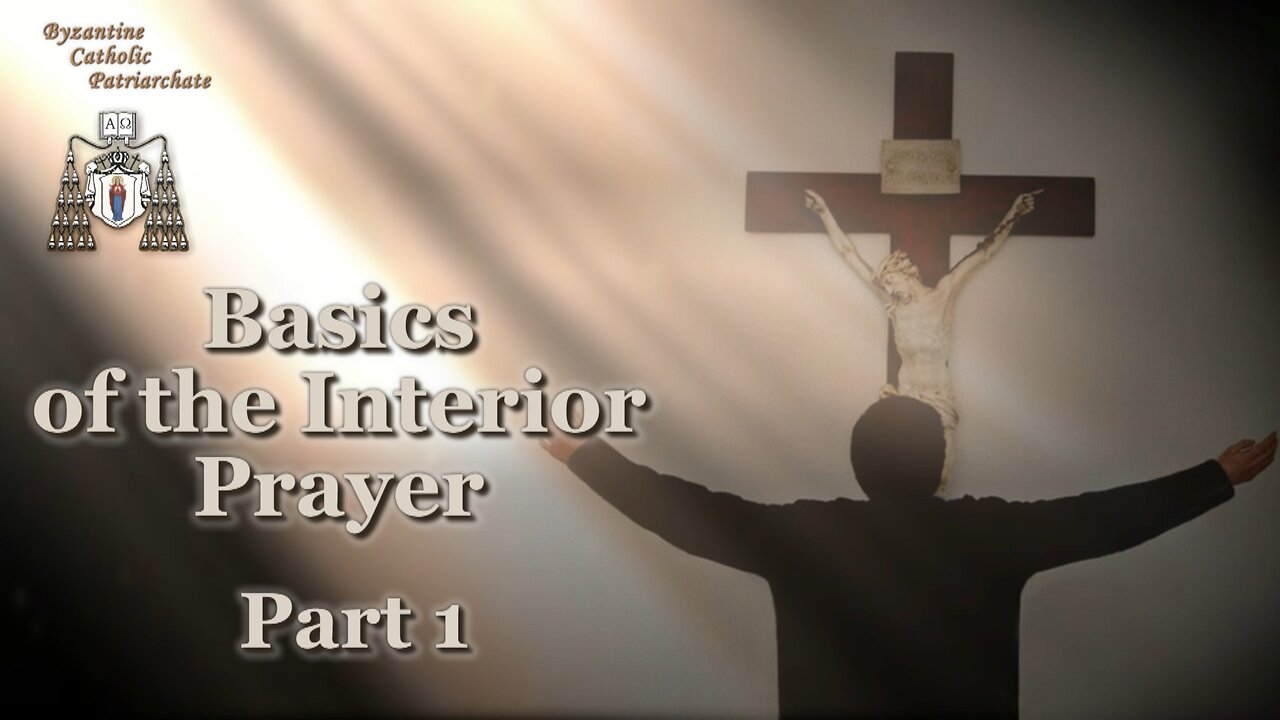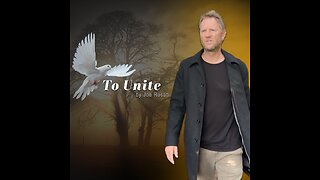Premium Only Content

Basics of the Interior Prayer /Part 1/
Watch this video on: https://vkpatriarhat.org/en/?p=24142
Subscribe to BCP newsletters https://bit.ly/3cJLzzm
In interior prayer, it is necessary to realize the essential truths that concern each person individually, namely death, God’s judgment, and eternity. Christian contemplation has traditionally focused on two areas. The first area is the last things of man, and the second is Christ’s suffering and His death. We return to these spiritual sources even now.
Principles of interior prayer
The prayer position is important. You kneel or stand with your arms up.
For the beginning and for a certain time, loud expression helps us focus our attention. Scripture says: “The Spirit Himself makes intercession for us with groanings which cannot be uttered.” (Rom 8:26) Praying in tongues is usually simplified here to two-syllable words. Many have experience of the words “mana” or “bara”. Other two-syllable words may also be used, but one must beware lest some of them refer to a pagan mantra, i.e. the name of a demon. The word mana is mentioned in Ex 16:31 and bara means create (Gen 1:1). Jesus refers to Himself as the spiritual bread, God’s manna. But this is not about the meaning of the words; in essence it is just a simple supporting speech disposing us to interior prayer. Psalm 28 and others mention this cry of our spirit: “Answer me when I call to You, O my God.”
As for contemplative orders, it is helpful to pray this interior prayer for three to five hours a day. It is possible to skip it one day a week.
If zealous women, retired women or tertiary women pray, they follow a set prayer schedule in proportion to their abilities.
As for priestly communities that devote Monday and part of Tuesday to prayer and the Word of God, it is appropriate to pray in this way for three hours at least on that day. The fourth hour can be spent praying the Breviary (Liturgy of the Hours) or the Rosary.
The introductory motivational word in prayer is used for beginners; later it is enough to introduce the next part only briefly.
When praying, it is advisable to have a watch, a notepad and a Bible handy.
The first part of the interior prayer is about contemplating the last things of man. In the second part, we focus on the cross of Christ and His redemptive death. The first contemplation lasts 20 minutes. We begin with the motivational word.
Motivational word for the first part:
God’s Word says: “You have come … to the city of the living God, the heavenly Jerusalem. You have come to thousands upon thousands of angels in joyful assembly, to the church of the firstborn, whose names are written in heaven. You have come to God, the Judge of all men…” (Heb 12:22f)
Become aware of the reality of death that awaits you. Jesus says: “Be ready, because you know neither the day nor the hour.”
The second truth: God’s judgment. Jesus says: “There is nothing concealed that will not be disclosed. You will have to give account for every idle word.”
The third truth: Eternal heaven, eternal hell. Both are eternal. We only have a lifetime to determine what our eternity will be like.
The fourth truth: God’s mercy lasts only for a lifetime and requires repentance: “If we walk in the light, the blood of Christ cleanses us from all sin.”
Now bring your sins to the cross of Christ and ask for forgiveness. Look with faith at Christ’s wounds, into His eyes, and receive forgiveness.
Then your own prayer follows in which you reflect on these four truths.
In the next part of the prayer – unlike the first part, which was more of a free contemplation – we intensely focus on God’s word.
Its beginning can be compared to the launch of a three-stage space rocket. It needs to expend the most energy to lift off and overcome the Earth’s gravity. Without inward and outward self-denial, we are unable to break free from the gravity of our self-centredness and vanity. Getting into the presence of God and then abiding in God’s word requires summoning up all our strength at the very beginning.
Motivational word for the next part (Rom 6:6)
“We know that our old self was crucified with Him (with Christ) so that the body of sin might lose its power…” The letter of Scripture is to be received in the Spirit of truth and applied in the same Spirit. The word co-crucified, Greek synestaurothe in the aorist tense, means that an event that happened in the past has a continuation in the present. Thus we can say: “was and is crucified”. But for our part, the verb “is”, which expresses a present reality, requires a faith that unites us at present to Jesus and to what He has done for us. This is a cooperation of faith on our part. We receive by faith and then abide in this reality and reckon with it in our lives. This is biblical – saving – faith. Try intensively to abide in the reality of this word and thus in God’s presence for a quarter of an hour. Keep your focus on the so-called present moment, which is an element of spiritual union in interior prayer – it is like time has stopped. Imagine yourself holding on to the cross or even hanging with your hands nailed to Jesus’ feet. The whole globe pervaded with the spiritual metastasis of evil, original sin, is hung on your feet. This metastasis is in every human soul. But now this whole system of evil is connected through you to the cross of Christ; this old self is now paralysed, crucified, that is, “the body of sin has lost its power” (Rom 6:6b). All human souls have been corrupted by one and the same old self, which is the body of sin. Hanging over the globe, you see a dark abyss beneath. Now you hold the old self nailed to the cross by faith. It is in you and it is in all people. Scripture says – our old self: “We know that our old self” – not only your old self, but our old self “was crucified with Christ”. Keep your mind focused on the words with Him, and from time to time look into the face of Jesus, aware that you are now in spiritual union with Him, that you are now together with Him. Hold on to this by faith, and do not let go. Do not let in any distracting thought or daydreaming; just abide in God’s word.
You feel a certain pressure of evil from the old self pulling you down. At that moment you can repeat in your thoughts, “I won’t let go!” and then again, “together with Him” (crucified with Him): In this way, not only my old self, but our old self is paralysed at this point of time – both in me and in you (all of you). This is your mission. You can think of the different continents: now the old self is paralysed, now, at this moment, the system of evil cannot work.
This quarter-hour is a spiritual struggle for vigilance in union with Jesus. You do not let in any thought; you just keep your mind focused on the word “together, together” (with Him). The spiritual infection, or the old self, is one; it is an infection from the devil. Today it may be likened to a harmful genetic spiritual vaccine. This spiritual poisoning is within us, even if we are not aware of it. But we see its negative fruits – all the evil and ultimately physical death. At the very moment you are spiritually united by faith to the cross of Christ, you paralyse this power of evil. Jesus has already paralysed the old self on Calvary. Our old self was crucified with Christ, as Scripture testifies. So Jesus was not crucified alone. Physically, He was, it is true, but spiritually He was crucified with the old self. At this moment, you are united to Jesus and you are a representative of sinners at the same time. You also act on their behalf, whether they like it or not, whether they are aware or unaware. Because the old self is also within you, you have the right to hold it nailed to the cross now. When you hold it nailed to the cross, it is not separated from other people, but is connected to them; they form one whole, a whole mechanism, a whole network. Through faith in God’s word you know, too, that our, I repeat – our – old self is now crucified with Christ through you. Was and is! This is a faith breaking from time into eternity.
That was an intensive quarter-hour of crucifixion with Christ. We know that this mystery of faith works in the spiritual realm. When you are united to Jesus crucified, He paralyses the whole dark organism of the old self in all souls. At that very moment, God’s grace works in these souls. Many receive the light to be converted, others tempted to commit evil are paralysed, the dying receive the grace of salvation.
Let us now proceed to the truth expressed in the following Bible verses: “When Jesus saw His mother, and the disciple standing by, He said to His mother, ‘Woman, behold your son!’ Then He said to the disciple, ‘Behold your mother!’ And from that hour that disciple received her into his own (eis ta idia).”
We abide in this truth for another 15 minutes, experiencing the spiritual transplantation of a new heart.
Try to perceive and experience the following words: Jesus saw the disciple – He now sees me as His disciple. Jesus speaks to the disciple – now He speaks to me. You can look into His eyes in spirit, and now you fulfil His legacy with the same faith and dedication as the disciple John by the cross. “That disciple received her into his own,” Greek eis ta idia, Latin in sua – that is, into his innermost self. How did he receive the Mother of Jesus into his own? Through faith.
The Mother of God said at Fatima: “In the end, my Immaculate Heart will triumph.”
These 15 minutes do not require increased concentration; the act of receiving the Mother of Jesus into our own and the words related to it can be experienced more freely.
When we spiritually receive the Mother of Jesus into our heart, we realise that she is the New Jerusalem, or the living temple of God, where God meets with His people (cf. Rev 21:2-3). The New Jerusalem is symbolized by a square (Rev 21:16).
We ask: How is our first mother Eve and her genetic spiritual code of evil in us humans? It cannot be seen, but we taste the fruits of this inherited evil on a daily basis. Through sin, Eve, the mother of the human race, received the devil’s infection, the poison of the infernal serpent, that is, pride and emancipation from God, or self-centredness. The Mother of Jesus is the new woman who, by contrast, crushes the head of the devil (Gen 3:15). She is the new Mother, the Mother of the firstborn – that is Jesus, and of the secondborn, who have received Jesus. Mary, the Mother of Jesus and our Mother, is full of grace – kecharitomene (Lk 1:28). We know that the essence of original sin consists in the loss of grace, and we fell from grace through the first woman Eve. The fact that Mary is full of grace means, in consequence, that she is all-immaculate, without the stain of sin passed on to us by the first mother, Eve.
Finally, you may realise: I have received the Mother of Jesus. I have a new heart.
We can devote the last five minutes of this hour to sharing testimony.
These two truths – the co-crucifixion (15 minutes) and the reception of the Mother of Jesus (15 minutes) – dispose us to receive the other four truths that are linked to the last four words from the cross. We will talk about them in the second part, in the introduction to the mystery of Christ’s death. Scripture says: “Do you not know that you were immersed through baptism into Christ’s death?” (cf. Rom 6:3f)
-
 LIVE
LIVE
Boxin
3 hours agoWe Star South Of Midnight (is it a Woke Joke?!)
768 watching -
 2:40:52
2:40:52
Tundra Tactical
17 hours ago $33.40 earned🛑 What The Hell Happened To Our Gun Rights?? May 2025 Edition
67.9K2 -
 2:26:01
2:26:01
The Connect: With Johnny Mitchell
19 hours ago $6.19 earnedHow A Los Angeles Drug Kingpin Sold 40 TONS OF WEED, Got Life In Prison & Then Pardoned By Trump
39.6K8 -
 25:22
25:22
Forrest Galante
11 hours agoPrivate Tour of Australia’s Best Aquarium
53.1K5 -
 LIVE
LIVE
Midnight In The Mountains
3 hours agoGaming w/ PER·SE·VER·ANCE | Star Wars Battle Front 2 - First Time Playthrough
144 watching -
 LIVE
LIVE
MrR4ger
3 hours agoMIDNIGHT R4GE - STAR WARS BATTLEFRONT 2 *Short cozy stream
42 watching -
 2:07:09
2:07:09
BlackDiamondGunsandGear
16 hours ago🔴 LIVE SHOW w/ DLD & Okayest Shooter
42.1K2 -
 LIVE
LIVE
BigDaddySlick78's Live Gaming Channel
4 hours ago💰I Pay You To Play Call of Duty Warzone Rebirth Island LIVE #callofduty #warzone #cod
19 watching -
 4:32
4:32
TruthStream with Joe and Scott
5 days agoTo Unite Music Video 2025 in 432 HZ written by Joe Rosati & Steve Collins. featuring Stephen Tenner, Kristen Capolino and KC Sunshine. Produced by Lewis Herms
66.7K15 -
 3:09:13
3:09:13
Joker Effect
19 hours agoFIRST EVER AMATEUR BOXING EVENT STREAMED ON RUMBLE! BOUGHT TO YOU BY WOLFSDEN BOXING!
89.3K12